Optics

|
Ibn
al-Haytham (965-1039) is generally thought to be the only
Islamic contributor to optics with his Kitab al-manazir
(Book on Optics). In the more erudite works on the
subject, such as by Lindberg, one finds other Muslim scientists
involved in the subject.[1]
Rashed, too, has
made extensive studies with respect to some authors such as
al-Farisi.[2]
Djebbar makes a brief list of other authors and their works:
-Al-Kindi (801-873): Risala fi ikhtilaf al-manazir
(Treatise on Divergences in Optics).
Risala fi islah kitab Uqlidis
(Book on the Corrections of the Optics of Euclid.
-Ibn
Isa (10th c): Kitab fi l-hala wa qaws quzah
(Book on the Halo and the Rainbow).
-Ibn
Mansur (10th c): Kitab al-Manazir (Book on
Optics)
-Al-Farisi (13th c): Tanqih al-manazir
(Revision of the Book of Optics).
-Ibn
Ma’ruf (16th ): Kitab nur hadaqat al-absar
(Book on the Light of Accuity…)[3]
The
following outline is unable to go into these works and will
focus instead on pre-Islamic optics and on Ibn al-Haytham.
Pre-Islamic
(Greek) Theories of Vision
Optics remained for about thirteen centuries the battlefield of
the Greeks and their followers, the symbol of cogitation and
speculation triumphant over experimentation. The Greeks were
roughly divided into two diametrically opposed camps around the
issue of vision; those who stood by the ‘intromission' theory,
something entering the eyes representative of the object, and
those who stood by ‘emission,' vision occurring when rays
emanate from the eyes and are intercepted by visual objects.[4]
Within each half of the argument, there were more divisions.
Omar
explains that among
intromission theorists, opinion varied considerably, for example
around the manner in which the image is transmitted to the eye,
the nature of the medium, and so on.[5]
The difficulty in coming to a cohesive, precise
conclusion on optics resided with the multiplicity of the
arguments, and the fact that proponents of different arguments
were inconsistent on many accounts.[6]
Without getting bogged down in the complexities of the Greek
arguments, here is a brief outline of the issue of vision as it
stood before the Muslims.[7]
Basically, as Omar
explains, there were two
diametrically opposed Greek theories of vision. The first, the
intromission theory (Aristotle, Galen and followers), explained
vision in terms of the entry into the eye of ‘something'
representative of the object. Opposed to this was the emission
theory (Euclid and Ptolemy and followers,) which held that
vision occurs when rays emanate from the eye and are intercepted
by visual objects.[8]
Almost without exception, the Greek intromission theorists were
physicists, and so adopted a physical approach to the problem of
vision. Before Aristotle, Greek Atomists sought to apply
philosophical views, explaining vision in terms of ‘a coherent
form, a thin film of atoms encompassing the object, which leaves
the object and enters the eye.’[9]
Aristotle's theory itself is largely based on general
observations, interpreted according to his own philosophical
system. The relation between the eye and the object is not made
clearer by Aristotle's denial of emission from the object. On
the halo and the rainbow, he even adopts a theory, which is
contrary to his own.[10]
The fact is that, while the intromission theory, and its various
versions, seems physically more sound than the emission theory,
it lacks the ability to explain the manifold phenomena presented
by vision.[11]
The emission theory (Euclid and his followers,)
maintains that a ray issues from the eye and proceeds to the
object of vision where its termination constitutes the act of
vision. The idea of
radiation from the eye relies (due to its author (Euclid) on
geometrical explanations for vision. It fails to take
account of physical, physiological and psychological elements
that affect vision. Ptolemy sought to harmonise the geometric
with physical approach. He even carried out some experiments in
support of his views. The problem, as raised by both Omar
and Hill, was that his
experimentation was to support his already preconceived theory,
even manipulating experiments for that purpose,[12]
which is the exact opposite of what experimentation is
supposed to achieve.
Both
intromission and emission theories, thus, suffer from exactly
what Greek science suffers from: its reliance on cogitation and
the lack of experimental foundation.
In
explaining the passage from Greek to Islamic optics, Lindberg,
very ingeniously, subdivides Greek optical theories into five
main strands:
1)
Aristotle's description of light as the actualisation of the
potential transparency of a medium by imposition of a form on
the medium and his intromission theory of vision.
2)
Neoplatonic views on the emanation of power.
3)
The opinion of Galen and others on the anatomy of the eye and
the physiology of sight.
4)
The intromission theory of the atomists.
5)
The geometrical tradition originated by Euclid and Ptolemy.
It
should be noted, Lindberg adds, that all of these strands,
except perhaps the second, are principally concerned with one
very fundamental question: How do we see? consequently, they
involve questions of a physiological and psychological sort as
well as of physics and mathematics.[13]
[1]
D.C. Lindberg: Studies in the History of Medieval
Optics (London, variorum; 1983).
D.C. Lindberg, Theories of Vision from Al Kindi to
Kepler (Chicago and London, 1976).
-A Catalogue of Medieval and Renaissance Optical
Manuscripts (Toronto; 1975).
[2]
I.e R. Rashed: Le Model de la Sphere transparente et
l'explication de l'arc en ciel: Ibn al-Haytham,
al-Farisi; in
Revue d'Histoire des Sciences;
Vol 23: pp 109-40.
[3]
A. Djebbar: Une Histoire, op cit; p. 268.
[4]
D.R. Hill: Islamic Science, op cit, p 70.
[5]
S.B. Omar
: Ibn al-Haytham's Optics: Bibliotheca Islamica (
[6]
See G.A. Russell: Emergence of Physiological optics, in
the Encyclopaedia (Rashed ed) op cit, pp 672-715;
pp 673-85 in particular.
[7]
D.C. Lindberg: Introduction in Optica Thesaurus:
Alhazen and Witelo; editor: H. Woolf. Johnson
(Reprint Corporation, New York, London, 1972).
D.R. Hill:
Islamic Science, op cit,
pp 70-1.
S.B. Omar
: Ibn al-Haytham's Optics; op cit; p. 17 fwd.
[8]
S.B. Omar
: Ibn al-Haytham’s Optics, op cit; p. 17.
[9]
Ibid; p. 18.
[10]
Ibid; p 19.
[11]
Ibid; p.20.
[12]
D.R. Hill: Islamic Science, op cit, p 71.
[13]
D.C. Lindberg: Introduction in
Optica
op cit;
p. xiv.
|





